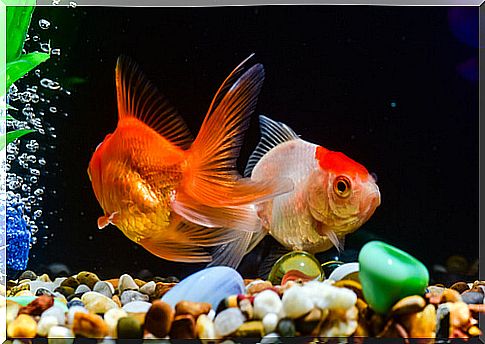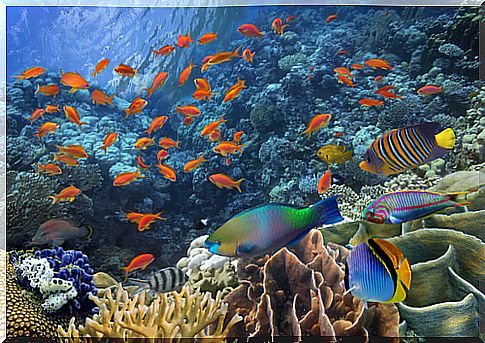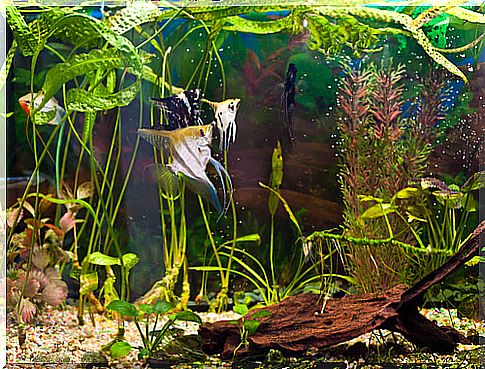Fish Feed: Tips To Make It Ideal

There are many species of fish in the world. Each of them has a specific diet, where temperature and climate also influence. When it comes to feeding fish, it is essential to know the nutritional needs of each species.
Fish food: nutritional characteristics of different species
Fish can be carnivores, herbivores, or omnivores, depending on the species. Knowing the habits and nutritional needs of your fish is the first step in providing them with a balanced diet.
Carnivorous fish
Carnivores are often excellent hunters in their natural habitat. They have a short intestine and feed once or twice a day. Proteins are easily digested and provide prolonged satiety.
They can feed on crustaceans, mollusks and smaller fish, such as sardines and herring. The main examples of carnivorous fish are tunas and sharks.

Although they have sharp teeth, carnivorous fish do not chew food either. In fact, their teeth are used to hunt and catch prey. But the food is actually ground up in the esophagus and in the stomach.
Herbivorous fish
There are very few strictly herbivorous fish species. These animals basically feed on native plants of the aquatic flora. They can fish in salty or fresh waters.
They have a long intestine, since vegetables require a prolonged digestive process. They also tend to eat several times a day to meet their nutritional needs. The best known herbivorous species are the maiden fish and the salpa.
Omnivorous fish
Many aquarium fish are omnivores. It is an important adaptation and survival skill. These animals are opportunistic and feed on both animal and plant protein. Their habits basically depend on the habitat to which they are exposed.
They usually eat 2 to 3 times a day, according to the proportion of protein they consume in each meal.
Tips to balance the diet for aquarium fish
Some attitudes are essential to avoid making mistakes when choosing aquarium fish food.
It is essential to know what species of fish to have, to give them an adequate diet. Afterwards, the following tips can be followed:
-
Don’t overfeed your fish
Choosing a good commercial feed according to the species of your fish is essential. But knowing when and how to feed them is just as important.
Overfeeding and being overweight are risk factors for the health of your fish. In fact, many tend to die as a result of the disease known as “fatty liver”.
Most owners offer an exorbitant amount of food. And that is not only dangerous for the weight of the fish. The accumulation of food on the bottom is the most common source of contamination in fish tanks.
Experts recommend the following ratio: 0.4 g per day for every 10 g of fish in the aquarium.
-
Make sure everyone eats
The way of feeding also varies according to the species. Each fish is anatomically prepared to eat at a certain density. Some eat on the surface, others in the center, and some at the bottom of the tank.
Therefore, it is very important to be attentive when feeding your fish. It is recommended to observe their habits to ensure that everyone is eating.
-
Provide live food
Dry commercial feed is excellent as a basis for fish feed. Among other things, because it contains the appropriate proportions for each species.

However, live food is essential for nutrition and the digestive and reproductive process of fish. They mean a basic supply of 100% natural protein and fibers.
Ideally, make a mixture with mosquito larvae, shrimp and Tubirex-type worms. That for carnivorous and omnivorous fish.
Herbivores can be offered algae and aquatic vegetables. Lettuce and spinach can also be blanched in boiled water and offered to your fish.
-
Avoid food accumulation
In addition to respecting the daily proportions of food, the inside of the fish tank should be cleaned once a month. Provided that there is an adequate filter system to keep the water in good condition.
-
Winter fish feed
When there is adequate heating for the fish tank, the fish should not undergo food changes with the arrival of the cold. Feeding can be done 2 to 4 times a day normally.
But when choosing to hibernate the fish, feed should only be offered once per day. Normally, fish trigger the hibernation process when the temperature drops below 10ºC.








